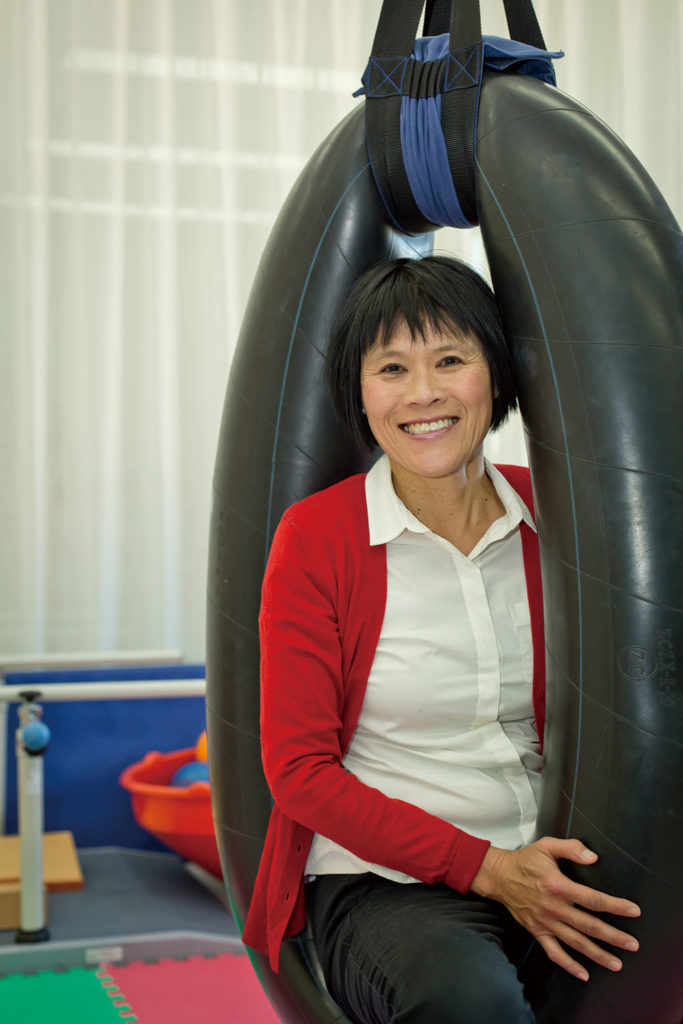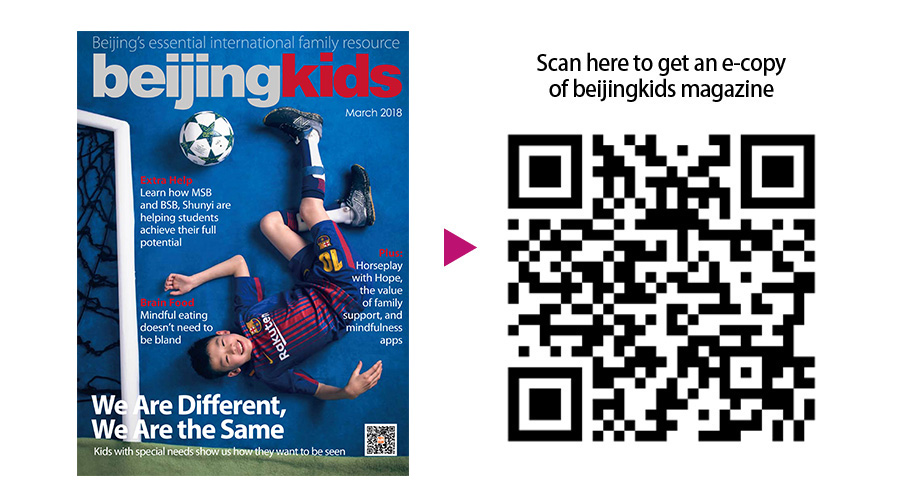
An occupational therapist is usually one of the first people you will consult when you discover that your child might need extra help in performing the daily tasks of life. Though it’s a position that no family wants to be in, an occupational therapist is there to guide you through the steps and give children and parents the tools needed to eventually lessen or even overcome their difficulty.
We talked with Eva Ma, an OT from Olivia’s Place with more than 20 years of experience in pediatric occupational therapy, discussing her journey into this sometimes tough, but undeniably rewarding profession, and how it has the potential to make a world of difference for individuals with special needs working towards a better and more independent future.
Tell us about your journey in the field of occupational therapy and what initially inspired you to get into this line of work?
I wanted to go into the medical field and was living with a family that had a daughter with multiple sclerosis. I was taking care of her as I was taking some of the lower level courses, so it allowed me to explore these occupational therapy related topics. It kept on coming up and really intrigued me.
Being an occupational therapist is nice because we can work in many different kinds of settings, including clinics, hospitals, and school districts, who always hire OTs. With our training, we can also work with adults and children, from cradle to old age.
Were there any moments at the beginning that made you realize that this was something that you wanted to continue with?
Well, I always liked working with people, but I liked working with children. You can look at children from 2 years old or 4 years old, and there’s a variety of personalities there. When I first started practicing, most of the children I worked with were not able to walk, not able to talk, some had cerebral palsy or other genetic problems, and just seeing them and their joy while learning to be more independent or express their needs to me was just wonderful. I’m always grateful that I get to enjoy that piece of the work.
When I graduated from my class, there were about 32 of us, and some of the co-workers decided to work with adults. I was working at a pediatric nursing home which was quite a unique situation in Portland, Oregon at that point. There weren’t many nursing homes serving children with severe disabilities. Some of my coworkers had a really hard time going to a place like that, with these children that were considered to be the worst of the worst. It just never bothered me. I just wanted to make them smile with a touch or a movement and get that small response.
What is an occupational therapist and what are they not?
I always joke that you need about two hours to explain what we do. As a profession, we are taking in information and knowledge from social workers, physical therapists, a little bit of nursing, and a little bit of psychology, so there’s not an easy way to define us. It’s a field that developed mostly in the United States, in the early 1930s, after World War I when the veterans were coming back from the war and recuperating from traumatic injuries. So the term “occupation” is intended to describe how to use your hands and how we occupy ourselves. With children, we use our hands to play and to explore. So there’s a lot of different things that we do. With adults, we look at how we balance our body, how we maintain sitting skills, how we use our arms, and maybe getting dressed, basic self-care, and even later having an occupation. Some people will receive on the job training. For an older person after a stroke, we will help them to regain skills, maybe compensating for not being able to move on one side of their body so that they may become as independent as possible.
After working in Beijing for three years, what are some noticeable changes that you have seen occurring here? Do you think there is a greater sense of awareness regarding these topics and what is required to help people with special needs?
Children with disorders like cerebral palsy usually are not being seen. You can see them maybe in an orphanage but not so much in a public school, which is different from America. But, I think now there is more discussion and talk about how we help these children.
I work with children with a disease called spinal muscular atrophy, and I get calls from the parents asking how they should help their child? While they may have a fairly high level of intelligence, they also might have a weak body. In these public schools, there’s not a support system established by the Chinese government. Some of the parents may need to hire one of their family members or maybe the mom will be the one going into the school to support the child giving one-on-one aid.
I also work with a lot of these Chinese parents that are really concerned about having their child with any kind of deficit that may bring challenges, rendering them unable to follow directions or unable to understand what’s asked of them in a pre-school setting. So, their biggest fear is how to get their son or daughter ready for primary school, and that’s a huge burden on a parent. Children dealing with autism is a common topic for a lot of parents, and currently generating a lot of anxiety or fear. If they feel that their child might not be able to fit in or able to follow directions, how will they deal with entering year-one by themselves?
What are some of the positive aspects of doing this work in China as opposed to places in the west?
It’s really exciting because you bring in so much information. The job for me is to reassure parents that there is hope and that things will get better. This is not the end. A lot of times when you receive a medical diagnosis, it can feel like a death sentence, but I feel like I can give them some ideas, and some encouragement to try different things and to remain open-minded. That’s really a great satisfaction for me working in China, providing a lot of information to people that may not otherwise be exposed to it.
So you are bringing things that you learned in America here to China, but is there anything that you are learning through working in Beijing that you feel could benefit occupational therapists in America?
There’s no one size fits all. I always think about it from a language standpoint. With a lot of the children we work with, we are trying to get them to talk, trying to get them to express themselves. I always laugh because, in Chinese, it’s quite common to say: “hao bu hao?” If they say “bu hao” then you can’t carry on. Back in America, we give children options, and there are degrees of yes and no. There are also many ways to say no. So in the language, I try to use it to slow things down, or we explore with the parents about how else we can say “no” without giving up completely. Communication is learning; if you don’t have the language, then you don’t learn.
I feel we are in a generation that isn’t talking as much face to face. We aren’t talking as much, and we’re relying on our devices to communicate more, and for someone with a behavioral disorder, this isn’t really helping. That’s the root of this disease as this primary function is removed. So we need to go back and review these foundational skills. Some children can learn naturally and can just copy each other, but some children need to be taught how to play or to be playful. The parents also need to be taught how to play and that this can help their children.
So it’s not only about teaching the child but also their parents?
Very much so! The parents are the ones with the children seven days a week. Maybe they come and see me once a week for one hour. That’s nothing, and what we call a drop in the bucket. The parent is the reference point for the child, the role model. Some parents are open to this, while others are more like “I don’t want you to talk to me, just fix my child.”
I’m sure with parents being on their phones during these sessions; it doesn’t help your sessions with these kids.
It’s cause and effect because people always say that “my son is so good with the iPhone.” So, we always have to explain that the iPhone is very predictable. If you do one stroke it will come up with this, if you do two strokes, it will come up with that, but then when you are playing with somebody things are unpredictable. We don’t know if the other boy will like the toys you are playing with, or if the other boy will take your food because he likes what you are eating. There is a lot of unpredictability about being a social animal. We want to nurture that attitude and being flexible.
Helping people overcome these difficulties is the primary aspect of being an occupational therapist, but how do you help families deal with the inevitable amount of failure that comes with trying to improve the situation?
For our training, we are constantly looking at adaptation. We are constantly assessing the situation. Is it too easy, or is it too hard? So even for teaching the child, we are constantly looking to create a successful experience. If it doesn’t work then how do we modify it?
How does an occupational therapist find balance between being supportive but realistic when it comes to the expectations of the family or patient?
It’s hard, especially because we are always the bearer of bad news. To be honest, if the child is developing or doing ok they don’t need to meet us. Purely by coming to our clinic, it means there is something wrong with that person’s child. I found that we need to be good listeners and nonjudgmental. Each mother and father are on their own journey, and they may be at a different point in their lives compared with the parents I just met an hour before them. So I honor their differences. We always think they should listen to us but really it is our job to present the pros and cons, and then it will be up to the parent to make a decision. We just plant the seeds.
You need to maintain a serious role but also be very playful and communicative; it must be tough.
I call it my actor’s face, because if I treat a child who is 2 years old with autism when I later have a 7 year old boy with ADHD or another type of deficit, I change my playfulness or how I talk to them. Maybe some psychologists do something similar, but the kind of occupational therapy that I do is a lot of active movements. This is how relationships build when children are having fun and enjoying the task they will want to do more. It’s a little bit like running a marathon, because you love that sensation, that runner’s high, and you will want to do it again. It’s basic neuroscience that if you do something that gives you joy, and you produce happy hormones, you want to do it again. Then you even do better at it. It’s magic to have a child that wants to do better. We are coaches, we are motivators, and we are teachers. It is a combination of things. Some of the children we work with really don’t have that concept or idea, so we want to be role models for them, with the idea that once they’ve done what they’ve set out to do, then they can come up with their own ideas. It’s intrinsic and the best for humans to do more on their own and to be as independent as possible.
Is there anything else that you think parents could benefit from knowing regarding what could be improved about special needs education in China?
I think advocacy. I think I would like to tell Chinese parents to stay together as a group even though the public school system is currently not supporting children like their’s, but the more they ask for it, it will come. It happened in the US, and it happened in Latin American countries, so the parents need to be the ones that demand it. Talk about it with others, even though in Chinese culture you often don’t talk about these things. But you need to realize that you are not alone. There are other parents that are going through the same process as you are, and that’s important to understand.
 Photos: Uni You
Photos: Uni You
This article appeared on p54-56 of beijingkids March 2018 issue.




